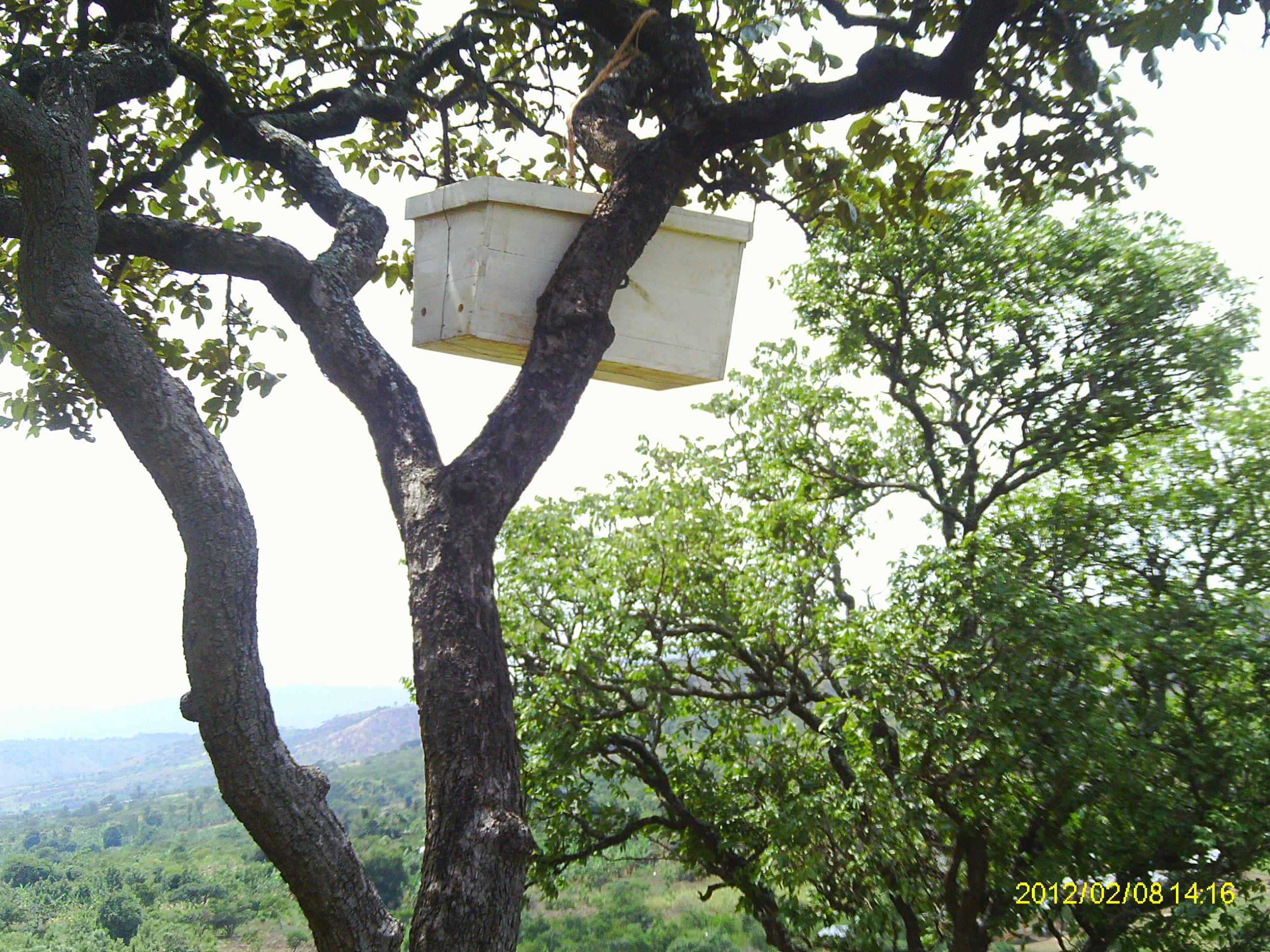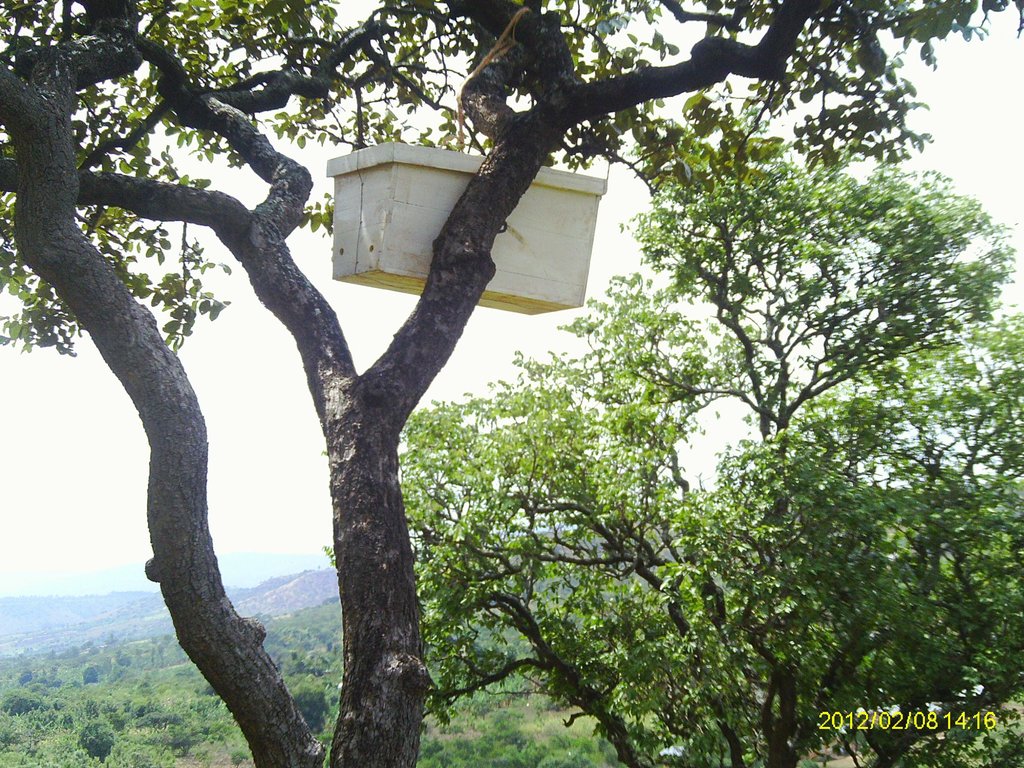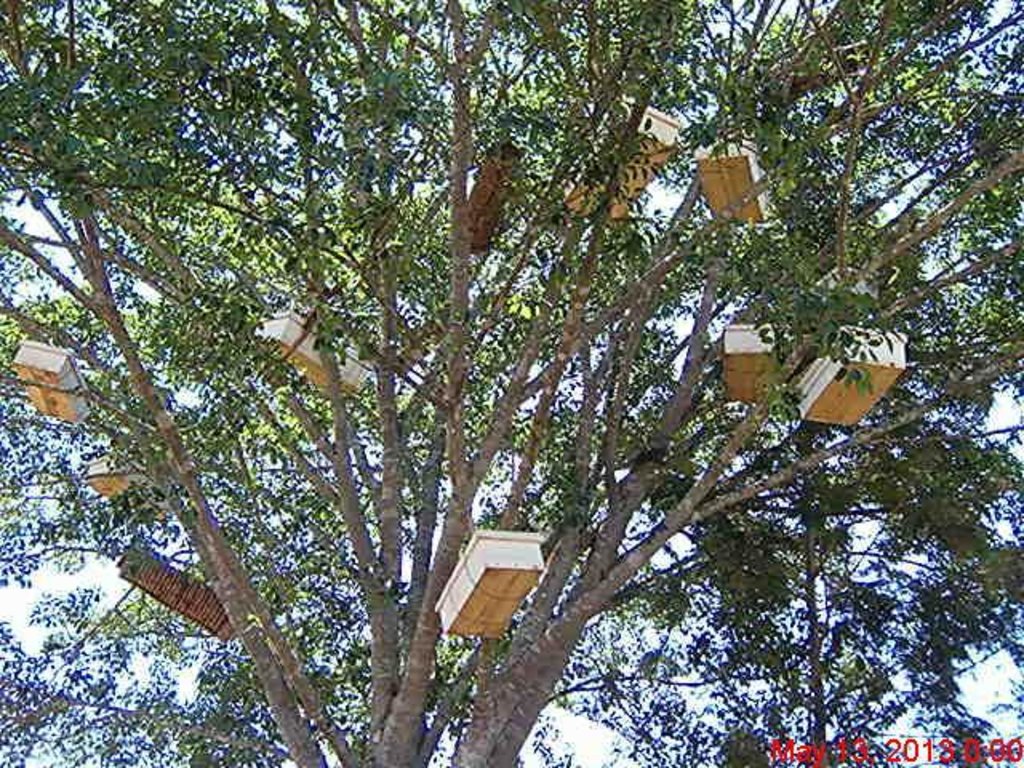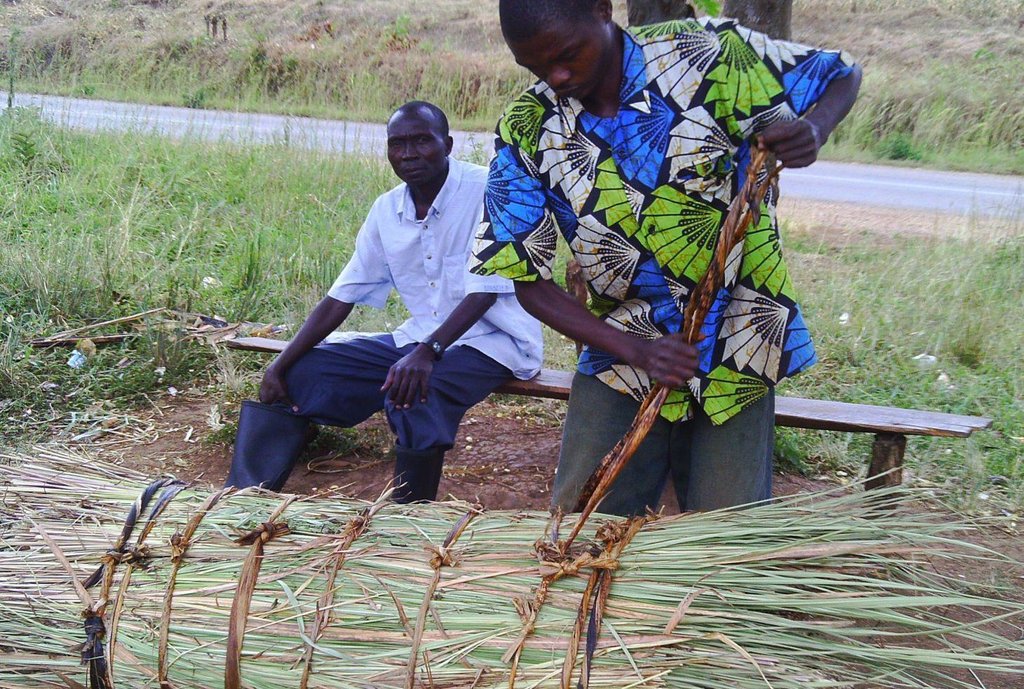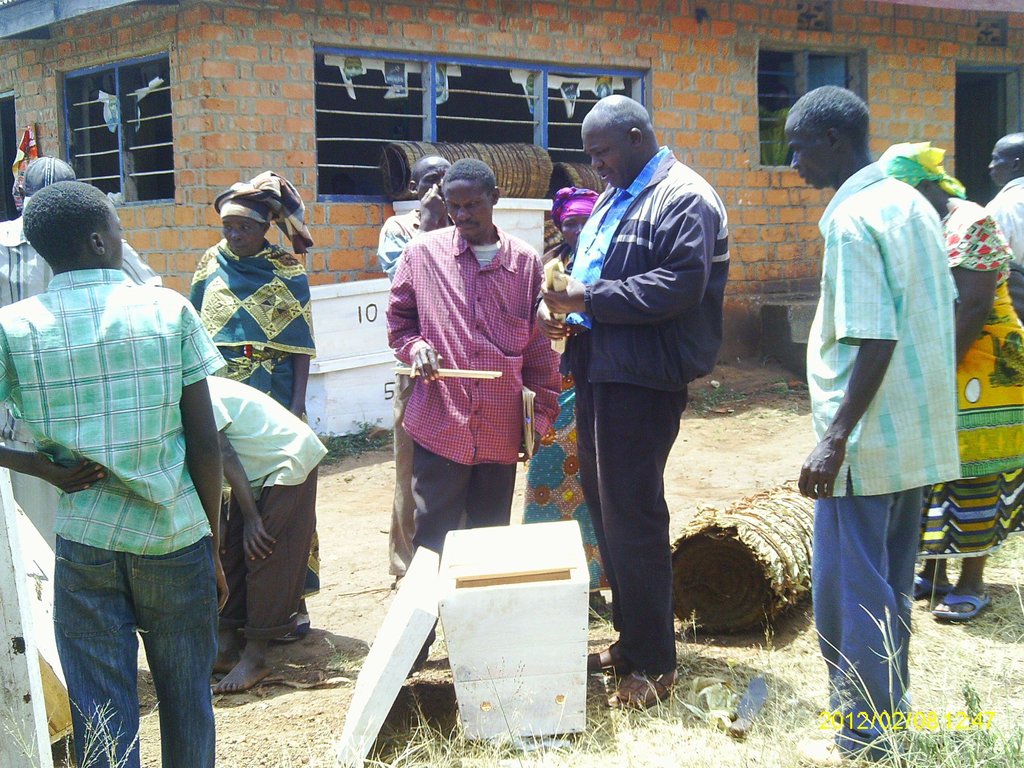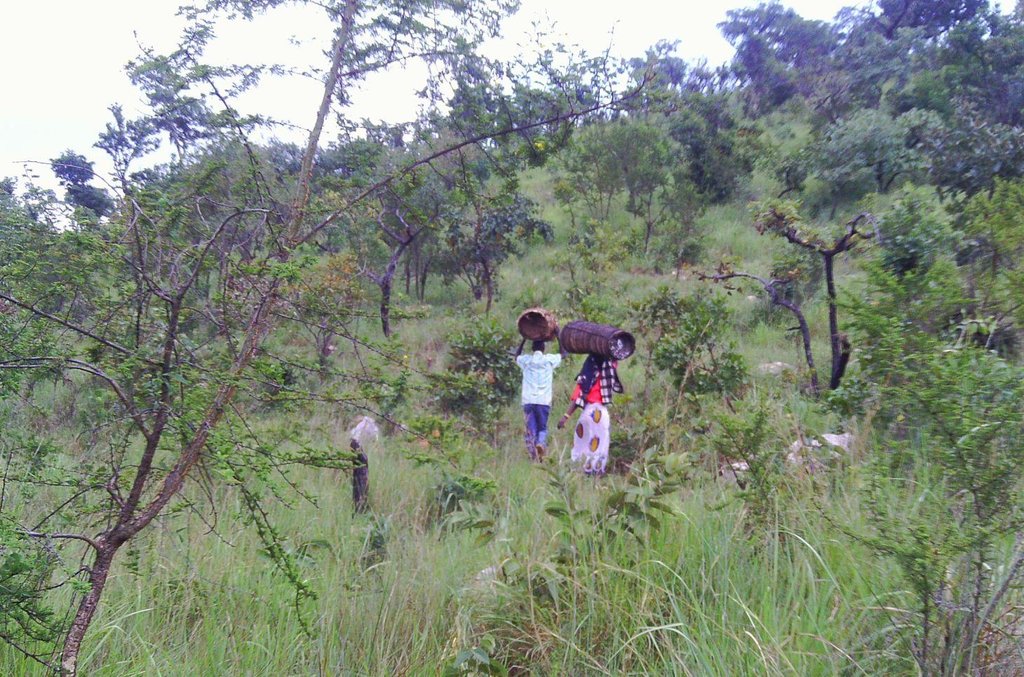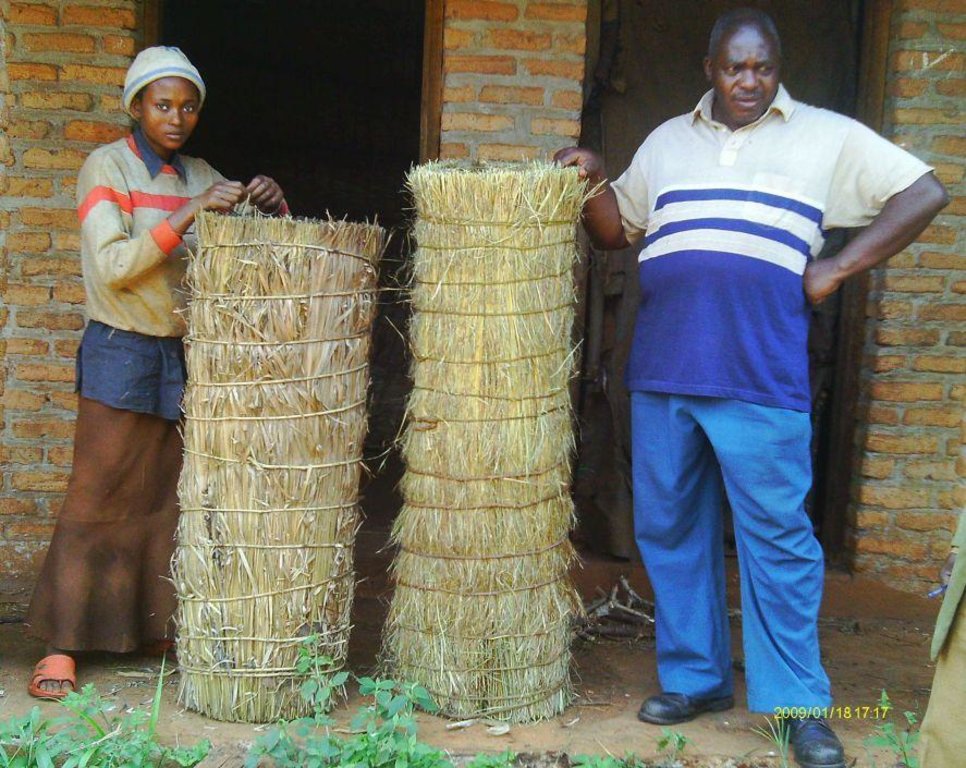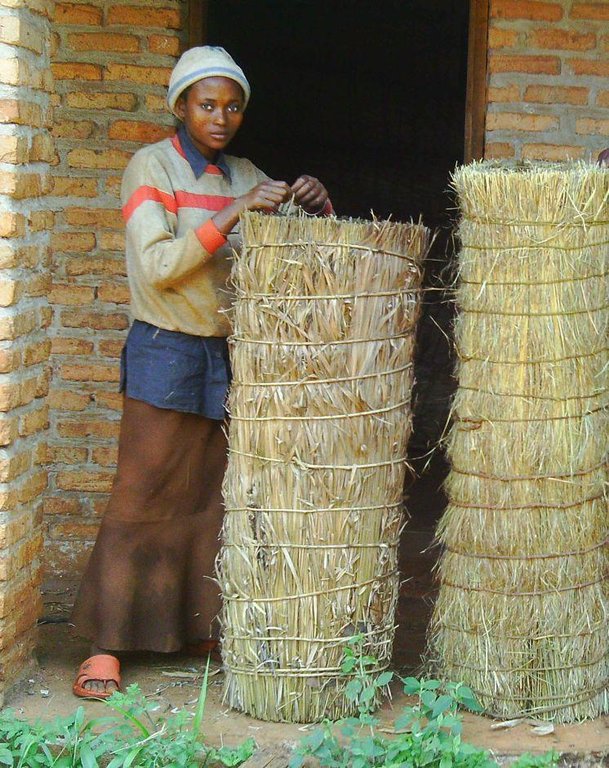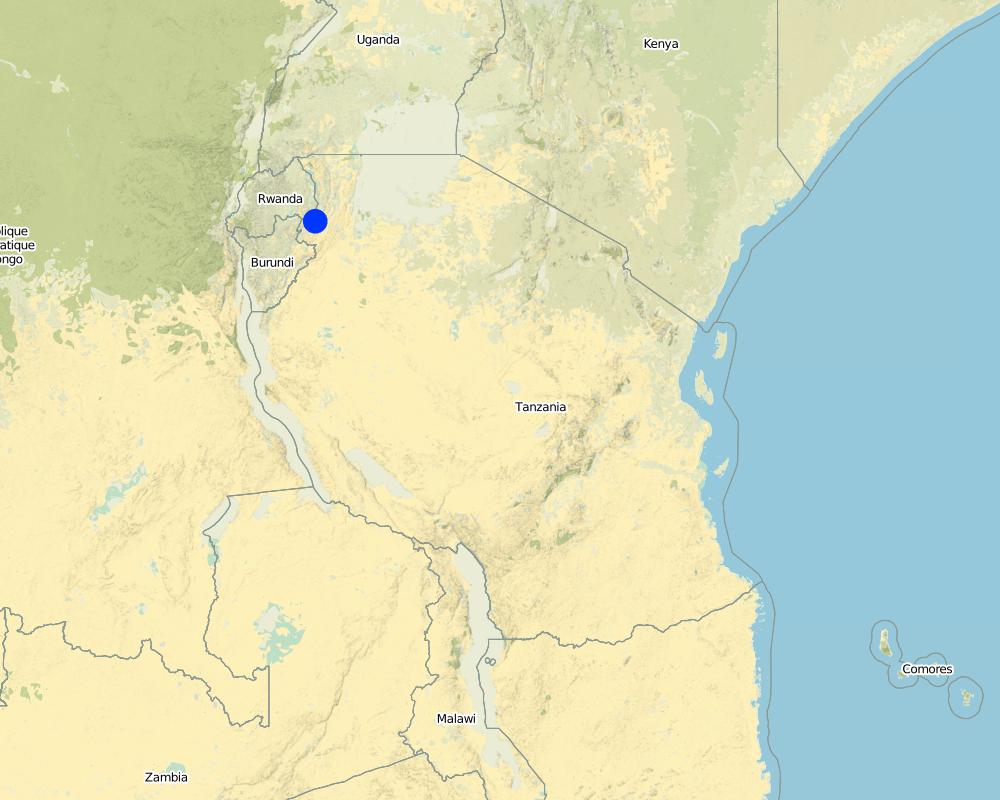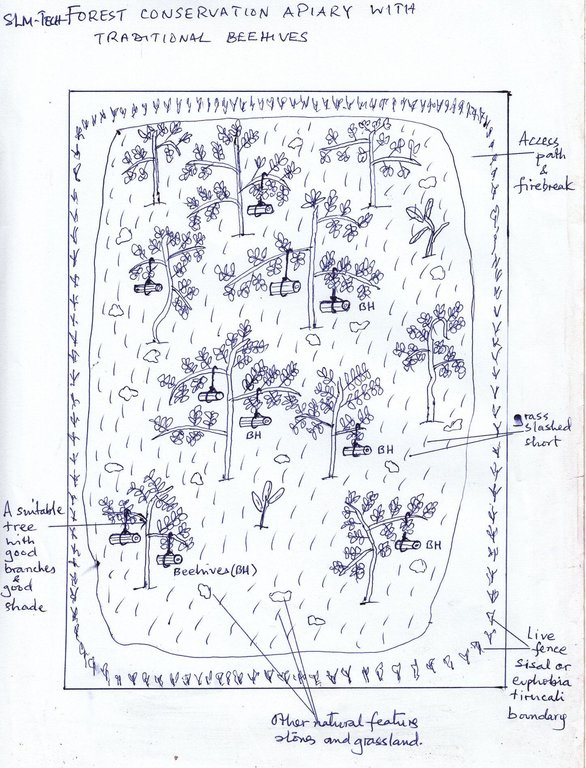Natural forest conservation using apiaries [Tanzania, United Republic of]
- Creation:
- Update:
- Compiler: Philip Ileta
- Editor: –
- Reviewers: David Streiff, Alexandra Gavilano
Utunzaji misitu kwa kufuga nyuki (swahili),
technologies_1152 - Tanzania, United Republic of
View sections
Expand all Collapse all1. General information
1.2 Contact details of resource persons and institutions involved in the assessment and documentation of the Technology
SLM specialist:
Government:
Waluce Michael
Ngara District Council
Tanzania, United Republic of
Government:
Mugishagwe Wilson
Ngara District Council
Tanzania, United Republic of
Government:
Sangatati Josephat
Ngara District Council
Tanzania, United Republic of
SLM specialist:
Kaihura Fidelis
K-TAMP
Tanzania, United Republic of
Name of project which facilitated the documentation/ evaluation of the Technology (if relevant)
The Transboundary Agro-ecosystem Management Project for the Kagera River Basin (GEF-FAO / Kagera TAMP )Name of the institution(s) which facilitated the documentation/ evaluation of the Technology (if relevant)
Food and Agriculture Organization of the United Nations (FAO) - ItalyName of the institution(s) which facilitated the documentation/ evaluation of the Technology (if relevant)
Ngara District Council (Ngara District Council) - Tanzania, United Republic of1.3 Conditions regarding the use of data documented through WOCAT
The compiler and key resource person(s) accept the conditions regarding the use of data documented through WOCAT:
Ja
1.5 Reference to Questionnaire(s) on SLM Approaches (documented using WOCAT)
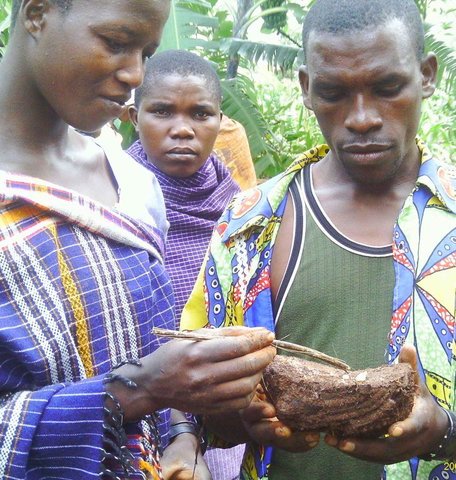
Community intergrated catchment ecosystem management [Tanzania, United Republic of]
Adaptive Agro-ecosystem Micro-catchment Approach.
- Compiler: ALLAN BUBELWA
2. Description of the SLM Technology
2.1 Short description of the Technology
Definition of the Technology:
Establishment of apiaries in natural forests to retard forest mismanagement and improve honey production
2.2 Detailed description of the Technology
Description:
This technology has been practiced in Ngara region for the last 50 year and involves construction and upkeep of apiaries for honey and related goods production. The apiaries are constructed by farmers (traditional) or purchased (modern box hieves) and then positioned in a designated forest area that is away from settlements and public places. The apiaries should be hanged on a strong branches of trees with good shade and the honey production process takes from 9 to 12 months.
Purpose of the Technology: It is recommended to apply this technology in the forest that is exposed to deforestation as apiaries help to enhance forest protection. The establishment of apiaries help to improve management of the natural forest while increasing production of honey. This will contribute to the better livelihood of the community and environmental wellbeing.
Establishment / maintenance activities and inputs: The described technology covers area of enclosed 4 hectares of natural forest and establishment of 365 apiaries (338 traditional, 27 box hives); the group of practitioners consist of 10 members (7 male and 3 female). The establishment procedures require: a) identification of forest at risk of degradation, b) ermarcation of the apiary forest, c) creefing of fire breaks d) reparations for and hanging the beehives (traditional and box hives). Maintanance acivities include a) regular slashing of grasses and bushes around the trees with hives b)grading with hand hoes the fire breaks/ roads around the entire forest for fire protection before each dry season c) cleaning of hives,repairs and harvest honey with bee protectives (bee smoker,bee veils,gloves) to eliminate the risks of fire in the forest.Patrol and guard tresspassers d) monitoring pests and diseases
Natural / human environment: Natural occuring tree species include: Combretus spp., Albizia spp., Parinari spp., Pericopsis spp. and Eucalyptus woodlots. Grazing areas are nearby but restricted by village by laws to tress pass in the forest apiary
The aipiaries should be located near permanent water sources because bees use water for honey production and cooling in the hives. Farmers with bee hives become more committed to protect their forest when they hang beehives in the area. Honey is harvested for consumption, trade and medicinal mixtures
The land users are small scale subsistance farmers with poor to average income/wealth,organised as a group of 10 farmers. the population density is between 200-500 people per square km and anual population growth at 2-3% Land ownership is both individual and communal but there are natural forestl areas owned communally through village governments where groups may access temporarily by request to establish environmental friendly activities such as forest apiaries.
2.3 Photos of the Technology
2.5 Country/ region/ locations where the Technology has been applied and which are covered by this assessment
Country:
Tanzania, United Republic of
Region/ State/ Province:
Tanzania
Further specification of location:
Ngara District
Specify the spread of the Technology:
- evenly spread over an area
If precise area is not known, indicate approximate area covered:
- < 0.1 km2 (10 ha)
Comments:
The described technology covers area of enclosed 4 hectares of natural forest. Applied 365 bee hives (338 traditional, 27 box hives); the practitioners group has 10 members (7male and 3 female)
Map
×2.6 Date of implementation
If precise year is not known, indicate approximate date:
- more than 50 years ago (traditional)
2.7 Introduction of the Technology
Specify how the Technology was introduced:
- as part of a traditional system (> 50 years)
Comments (type of project, etc.):
Beekeeping using local hives is a tradtional practice among the the Hangaza and Shubi ethinic tribes of Ngara district
3. Classification of the SLM Technology
3.1 Main purpose(s) of the Technology
- protect a watershed/ downstream areas – in combination with other Technologies
- preserve/ improve biodiversity
3.2 Current land use type(s) where the Technology is applied

Forest/ woodlands
- Combretus spp., Albizia spp., Parinari spp., Pericopsis spp. and Eucalyptus woodlots
Products and services:
- Fuelwood
- Other forest products
- Grazing/ browsing
- Nature conservation/ protection
Comments:
Major land use problems (compiler’s opinion): Deforestation and fire burning during dry season
Reduction of biodiversity
Major land use problems (land users’ perception): Droughts and vegetation burning during dry seasons
Problems / comments regarding forest use: the natural forest has been set aside for establishing bee apiaries therefore only forest managenet operation are conducted(slashing of grass)
3.4 Water supply
Comments:
Number of growing seasons per year:
2
Specify:
Longest growing period in days: 120; Longest growing period from month to month: Sept-December; Second longest growing period in days: 90; Second longest growing period from month to month: March to May
3.5 SLM group to which the Technology belongs
- area closure (stop use, support restoration)
- beekeeping, aquaculture, poultry, rabbit farming, silkworm farming, etc.
3.6 SLM measures comprising the Technology

agronomic measures
- A7: Others

management measures
- M3: Layout according to natural and human environment
3.7 Main types of land degradation addressed by the Technology

biological degradation
- Bc: reduction of vegetation cover
- Bh: loss of habitats
- Bq: quantity/ biomass decline
- Bf: detrimental effects of fires
- Bs: quality and species composition/ diversity decline
Comments:
Main type of degradation addressed: Bc: reduction of vegetation cover, Bh: loss of habitats, Bq: quantity / biomass decline, Bf: detrimental effects of fires, Bs: quality and species composition /diversity decline
Main causes of degradation: deforestation / removal of natural vegetation (incl. forest fires) (Deforestation through cutting of trees), over-exploitation of vegetation for domestic use (Mainly for firewood), industrial activities and mining (Firewood for burning bricks made from clay), droughts, land tenure (Lack of village land use plans for the area), governance / institutional (Weak natural resources enforcent institution at village level)
Secondary causes of degradation: overgrazing
3.8 Prevention, reduction, or restoration of land degradation
Specify the goal of the Technology with regard to land degradation:
- prevent land degradation
- reduce land degradation
Comments:
Secondary goals: mitigation / reduction of land degradation
4. Technical specifications, implementation activities, inputs, and costs
4.1 Technical drawing of the Technology
Technical specifications (related to technical drawing):
Layout of natural apriaries (beehives BH) placed on the trees (good braches with shade), access path and firebreak and live fence.
Ngara district Council
Date: 15 May 2012
Technical knowledge required for field staff / advisors: moderate (To extend knowledge/skills on modern/sustainable beekeeping)
Technical knowledge required for land users: moderate (To add/improve skills on existing indigineous knowledge)
Main technical functions: indirectly minimize deforestation, indirectly increase of biomass
Secondary technical functions: promotion of vegetation species and varieties (quality, eg palatable fodder), control of fires, reduction of dry material (fuel for wildfires), spatial arrangement and diversification of land use
Aligned: -along boundary
Vegetative material: O : other
Change of land use practices / intensity level: Establishment of bee apiaries in forest to add on value/productivity and optimise diversification of land use
Layout change according to natural and human environment: The site should be away at least 400m from nearby settlements/public places
Major change in timing of activities: Twice per year Feb and Sept during honey harvesting season management activities are at their peak.
- Fire breaks established in June /July before dry season commence
Control / change of species composition: Various flora and fauna organisms get time to establish and grow well due to absence of burning
Author:
Ileta Philip, P.O BOX 30, Ngara
4.2 General information regarding the calculation of inputs and costs
Specify currency used for cost calculations:
- USD
Indicate average wage cost of hired labour per day:
1.25
4.3 Establishment activities
| Activity | Timing (season) | |
|---|---|---|
| 1. | Purchase of hives and binding wires | Before dry season |
| 2. | Purchase of beekeeping protectives | Routine |
| 3. | Slashing, screefing bushes and tall grasses; planting hedge around forest boundary | Before dry season |
| 4. | Baiting and hanging apiaries | Before dry season |
| 5. | Purhase of cuttings (euphobia spp) | wet season |
Comments:
FOREST CONSERVATION APIARIES technology REVISED PART-November 2013 Description and purpose This is a practice where farmers hang bee hives on branches of trees in the forest and keep the honey bees between six to twelve months whereby honey is already mature for harvesting. Conventional beekeeping methods have introduced other practices such as placing beehives on stands/platforms and keeping many hives in the shelter bee houses whereby honey production can be increased. The trees and forest where bee hives are hanged are normally respected and not felled indiscriminately.
Identification of suitable trees/forest Bees forage on nectar and pollen from flowers of many trees, herbs, shrubs and field plants. However there are specific plant species which are more preferred were bees visit more frequently. The forest or locality with rich biodiversity of the suitable trees/plants is conducive for establishment of a bee apiary. Prominent tree species in this zone include Parinari curatelifolia, Combretum spp, Brachtegia spp, Albizia spp, Acacia spp and cultivated crops such as banana, coffee, and annual crops which include maize, bean and sorghum The source of permanent water should be nearby preferably not more than 3kms because bees use much water in feeding, making honey and to perform cooling in the hives. Demarcation of the apiary forest It is usual for the beekeepers to demarcate the areas so as to inform and alert the community members the existence of the beehives. The demarcation signs may involve partially debarking part of the stem bark of the border trees. The use of colour paints, planting of hedge rows and other boundary marker plants are increasingly becoming popular around many forest apiaries. The common plants for live fence include Euphorbia tirucali, Agaves sisalana and Dovyalis caffra. Types of bee hives Common traditional beehives involve log hives, small poles/withies hives, straw hives, calabashes and clay pots. The use of modern box hives has increased in recent years mainly due to development projects support in modern beekeeping methods. Local hives are cheap but not durable limited to one to three years lifespan and the production is low compared with box hives which may last for ten or more years under good care. Preparations for hanging the beehives i) Bait materials Farmers utilize some materials to attract bee colonies establish in the hives. These include smoking or burning of dry honey combs and rubbing of beeswax inside the hives. Other methods involve sprinkling of either maize flour, cassava flour, raw honey or sugar. The use of many types of herbs and other less known substances(less revealed) to rub and smoke in the beehives before hanging is observed to be more effective in some communities. Some traditional beekeepers have become popular and earn money and respect through providing such services .The swarming periods which normally happen in January/Feb and Mid August/ Sept are suitable for hanging the beehives because it may not take long time to pocess the bee colonies ii) Ropes and tree climbing devices The hives has to be carried to the apiary and be hanged up on a tree branch. This may involve transporting the beehives using any transport means and carry on head load for some distance depending on accessibility and the location of the forest apiary. One or two person has to climb the tree and others remain on the ground to lift the hive. The hive is round bound with strong tree bark ropes before hanging The use of sisal ropes and binding wires have replaced the traditional methods to tie and fix the hives in modern beekeeping apiaries. A tall ladder may be helpful to assist in climbing of tall trees in case of aged individuals. The bee shelter house/huts and hive stands These are normally located in the forest apiary and constructed with local materials especially tree poles, straws and thatched on top roof with dry grass or other leafy vegetation such as banana, coconut and many others plants depending on availability. The hut walls are left open without covering the round walls with earth to facilitate cooling with the fresh air movements. The bee hives are placed on top of each other on the 1.2 m high erected tree poles stands. This practice enables to have many bee hives in one house which are easy to manage and protect provided the surrounding flora has good potential of bee forage plants. Water and sugars may be provided in special containers as extra feeds during bad weather conditions
4.4 Costs and inputs needed for establishment
| Specify input | Unit | Quantity | Costs per Unit | Total costs per input | % of costs borne by land users | |
|---|---|---|---|---|---|---|
| Labour | Slashing, screefing bushes and tall grasses | persons/day | 100.0 | 0.63 | 63.0 | 100.0 |
| Labour | Baiting and hanging apiaries | persons/day | 100.0 | 0.63 | 63.0 | 100.0 |
| Equipment | Hives and binding wires | pieces | 400.0 | 2.25 | 900.0 | 50.0 |
| Equipment | Beekeeping protectives | sets | 4.0 | 93.75 | 375.0 | 80.0 |
| Plant material | Cuttings | bundles | 200.0 | 0.3 | 60.0 | 100.0 |
| Total costs for establishment of the Technology | 1461.0 | |||||
| Total costs for establishment of the Technology in USD | 1461.0 | |||||
Comments:
Duration of establishment phase: 2 month(s)
4.5 Maintenance/ recurrent activities
| Activity | Timing/ frequency | |
|---|---|---|
| 1. | Slashing grasss,bushes and firebreaks | Before dry season |
| 2. | Apiaries repair | Regular |
| 3. | Monitoring of bee pests and diseases | Regular |
Comments:
Bush fire control This is done before the onset of the dry season by establishment of firebreaks around the apiary and slashing short the tall grass and other unwanted vegetation in the apiary forest. Cleaning, repairng and fixing the beehives The beehives that have become loose ,damaged or fallen due to strong winds, rains and disturbance by intruders or animals and birds requires replacement or renovations. In many cases pests such as ants, termites and rodents attack bees and make them abandon the hive. Such hives require repairs and cleaning inside before another bee colony can establish Honey harvesting. There is usually one major honey flow season starting May/June to Sept/October in most places, but another minor season may occur in February depending on the abundance of flowering in the previous season. Traditional honey harvesting equipments and tools include clay pots and other local containers, a hive knife and a smoking/burning grass appliance like torch to kill or scare away the bees. Modern beekeeping make use of special set of equipments and protective clothes that include an overall, a veil, a hat, a bee smoker, gloves, boots and hive tool. During harvesting the last two to three combs of honey are left in the hive to enable the colony continue to feed and resume manufacture honey for the following season Honey processing, packaging and marketing Raw honey is strained and filtered from the chopped honey combs through a clean linen or cotton cloth. The honey storage devices include plastic buckets, jerry cans and small (0.5 to 1 litre) plastic or glass bottles which sales between 2 to 4 US dollars at roadsides in the local market. Uses of honey The sweet and delicious fluid becomes ready for consumption or sale. There are many other uses which include brewing, medicine, in cosmetics, making candles and shoe shine pastes. Bees wax is obtained after boiling and cooling the filtered honey combs juice. Good quality raw honey should be light brown in colour, free from impurities such as any dirty, bee legs, wings and less pollen. Honey can be stored for many years due to its bactericidal and bacterial static properties. Boiled honey is of less quality, light in density, colour and loses most of its chemical and medicinal properties Philip Ngara Tanzania
4.6 Costs and inputs needed for maintenance/ recurrent activities (per year)
| Specify input | Unit | Quantity | Costs per Unit | Total costs per input | % of costs borne by land users | |
|---|---|---|---|---|---|---|
| Labour | Slashing grasss, bushes and firebreaks | persons/day | 60.0 | 1.25 | 75.0 | 100.0 |
| Labour | Apiaries repair | persons/day | 20.0 | 0.8 | 16.0 | 100.0 |
| Labour | Monitoring of bee pests and diseases | persons/day | 20.0 | 0.8 | 16.0 | 100.0 |
| Total costs for maintenance of the Technology | 107.0 | |||||
| Total costs for maintenance of the Technology in USD | 107.0 | |||||
Comments:
Machinery/ tools: Matchets,Slashers,Hoes,,Ropes,ladder for climbing trees.Binding wires
labour per hectare year 2011
tools per piece/each year 2011
4.7 Most important factors affecting the costs
Describe the most determinate factors affecting the costs:
High prices of equpipment an (especially box hives) and labour
5. Natural and human environment
5.1 Climate
Annual rainfall
- < 250 mm
- 251-500 mm
- 501-750 mm
- 751-1,000 mm
- 1,001-1,500 mm
- 1,501-2,000 mm
- 2,001-3,000 mm
- 3,001-4,000 mm
- > 4,000 mm
Specifications/ comments on rainfall:
Bimodal-(sept to december)and Feb to May/June
Agro-climatic zone
- sub-humid
Thermal climate class: tropics. Hot months(June,July,August,September),cold months(March,April),cool months(May,October)
5.2 Topography
Slopes on average:
- flat (0-2%)
- gentle (3-5%)
- moderate (6-10%)
- rolling (11-15%)
- hilly (16-30%)
- steep (31-60%)
- very steep (>60%)
Landforms:
- plateau/plains
- ridges
- mountain slopes
- hill slopes
- footslopes
- valley floors
Altitudinal zone:
- 0-100 m a.s.l.
- 101-500 m a.s.l.
- 501-1,000 m a.s.l.
- 1,001-1,500 m a.s.l.
- 1,501-2,000 m a.s.l.
- 2,001-2,500 m a.s.l.
- 2,501-3,000 m a.s.l.
- 3,001-4,000 m a.s.l.
- > 4,000 m a.s.l.
Comments and further specifications on topography:
Slopes on average: The technology is not affected with slope variations
Landforms: The site of the forest apiary is located on hill slopes
5.3 Soils
Soil depth on average:
- very shallow (0-20 cm)
- shallow (21-50 cm)
- moderately deep (51-80 cm)
- deep (81-120 cm)
- very deep (> 120 cm)
Soil texture (topsoil):
- medium (loamy, silty)
Topsoil organic matter:
- medium (1-3%)
If available, attach full soil description or specify the available information, e.g. soil type, soil PH/ acidity, Cation Exchange Capacity, nitrogen, salinity etc.
Soil depth on average: The depth of soil affects the vigour of grass,trees and other vegetation thus amount of biomass available for fire threat during fire season,the labour required for maintanance etc
Soil fertility is medium
Soil drainage / infiltration is medium
Soil water storage capacity is medium
5.4 Water availability and quality
Ground water table:
> 50 m
Availability of surface water:
good
Water quality (untreated):
good drinking water
Comments and further specifications on water quality and quantity:
Ground water table: On hill slopes
Water quality (untreated): The site for good drinking water is located some 400m proximal to the natural spring water source used for domestic supply and the Ruvuvu river is not far approximatle 2.kms. Poor drinking water at valley bottoms and wetlands nearby (4kms) and water for agricultural use only in wetlands, is used seasonally for dry season agriculture
5.5 Biodiversity
Species diversity:
- medium
Comments and further specifications on biodiversity:
Degraded mostly by fire,overcutting of trees for firewood
5.6 Characteristics of land users applying the Technology
Market orientation of production system:
- subsistence (self-supply)
- mixed (subsistence/ commercial)
Off-farm income:
- less than 10% of all income
Relative level of wealth:
- poor
- average
Individuals or groups:
- groups/ community
Gender:
- men
Indicate other relevant characteristics of the land users:
Land users applying the Technology are mainly common / average land users
Difference in the involvement of women and men: -Very few women were invoved trditionally-due to climbing of trees to hang bee hives and honey harvesting.These are activities usually performed by men
-Women perform slashing of grass, processing of honey and marketing of products
Population density: 100-200 persons/km2
Annual population growth: 2% - 3%; 3%
20% of the land users are average wealthy and own 50% of the land.
80% of the land users are poor and own 50% of the land.
Off-farm income specification: A small number of people practice off farm activities in burnt bricks making and petty trade
Market orientation of production system: Honey for market, very little for consumption
5.7 Average area of land used by land users applying the Technology
- < 0.5 ha
- 0.5-1 ha
- 1-2 ha
- 2-5 ha
- 5-15 ha
- 15-50 ha
- 50-100 ha
- 100-500 ha
- 500-1,000 ha
- 1,000-10,000 ha
- > 10,000 ha
Is this considered small-, medium- or large-scale (referring to local context)?
- small-scale
Comments:
Average area of land owned or leased by land users applying the Technology: Also 1-2 ha
The population density is low with a large ares of forests(55% of total area) still marginally disturbed
5.8 Land ownership, land use rights, and water use rights
Land ownership:
- communal/ village
- group
Land use rights:
- communal (organized)
Comments:
The group was allocated the forest area of approximately 4 ha by village govt to establish the forest apiary.
5.9 Access to services and infrastructure
health:
- poor
- moderate
- good
education:
- poor
- moderate
- good
technical assistance:
- poor
- moderate
- good
employment (e.g. off-farm):
- poor
- moderate
- good
markets:
- poor
- moderate
- good
energy:
- poor
- moderate
- good
roads and transport:
- poor
- moderate
- good
drinking water and sanitation:
- poor
- moderate
- good
financial services:
- poor
- moderate
- good
6. Impacts and concluding statements
6.1 On-site impacts the Technology has shown
Socio-economic impacts
Production
crop production
wood production
Comments/ specify:
Trees not scotched by fire,trees growing smoothly
risk of production failure
product diversity
production area
Comments/ specify:
Increased productivity per area of forest
energy generation
Comments/ specify:
Retention of permanent vegetation cover
Income and costs
farm income
Comments/ specify:
Increased opportunities for crop pollination in nearby fields
diversity of income sources
Comments/ specify:
Honey and beeswax primary products for sale from apiary
Socio-cultural impacts
food security/ self-sufficiency
Comments/ specify:
Sale of bee products during good harvest to contribute to household income
health situation
Comments/ specify:
Honey demand in herbal mixtures for diseases cure
cultural opportunities
Comments/ specify:
Reduce fire incidences
recreational opportunities
Comments/ specify:
The forest is beautiful to visit
community institutions
Comments/ specify:
Group cohesion due to common interests/income opportunities
SLM/ land degradation knowledge
conflict mitigation
livelihood and human well-being
Comments/ specify:
Increased income for the group members through sale of bee products honey as food and for diseases treatments members have attended various training for forest management and modern beekeeping members have incresed access to loans and credit organisations
dangers of bee attack
Comments/ specify:
When tresspassing people and animals or during swarming and harvesting honey
Ecological impacts
Water cycle/ runoff
water quantity
surface runoff
Comments/ specify:
Retention of permanent vegetation cover
evaporation
Comments/ specify:
Retention of permanent vegetation cover
Soil
soil moisture
Comments/ specify:
Retention of permanent vegetation cover
soil cover
Comments/ specify:
Retention of permanent vegetation cover
soil loss
Comments/ specify:
Retention of permanent vegetation cover
soil compaction
Biodiversity: vegetation, animals
biomass/ above ground C
Comments/ specify:
Retention of permanent vegetation cover
plant diversity
beneficial species
Comments/ specify:
Retention of permanent vegetation cover
habitat diversity
Comments/ specify:
Retention of permanent vegetation cover
Climate and disaster risk reduction
emission of carbon and greenhouse gases
fire risk
Comments/ specify:
Retention of permanent vegetation cover
wind velocity
Comments/ specify:
Retention of permanent vegetation cover
Other ecological impacts
pollination of forest and crops
6.3 Exposure and sensitivity of the Technology to gradual climate change and climate-related extremes/ disasters (as perceived by land users)
Gradual climate change
Gradual climate change
| Season | increase or decrease | How does the Technology cope with it? | |
|---|---|---|---|
| annual temperature | increase | not well |
Climate-related extremes (disasters)
Climatological disasters
| How does the Technology cope with it? | |
|---|---|
| drought | not well |
Comments:
By planting fire tolerant plant species around boundaries of the forest, beehives will be more secure from fire damage and the forest apiary remain with vegetative soil cover -such species includes agaves sisalana,euphobia tirucali etc
6.4 Cost-benefit analysis
How do the benefits compare with the establishment costs (from land users’ perspective)?
Short-term returns:
slightly negative
Long-term returns:
positive
How do the benefits compare with the maintenance/ recurrent costs (from land users' perspective)?
Short-term returns:
positive
Long-term returns:
positive
Comments:
After initial high establishment costs,maintanance costs are minimal and the box hives are durable for at least 10 years when made from durable well seasoned timber
6.5 Adoption of the Technology
- > 50%
If available, quantify (no. of households and/ or area covered):
32 households in an area of 10 ha
Of all those who have adopted the Technology, how many did so spontaneously, i.e. without receiving any material incentives/ payments?
- 11-50%
Comments:
17 land user families have adopted the Technology with external material support
Comments on acceptance with external material support: The box hives and beekeeping protectives were subsidies from projects/programmes under NGOs and governemnt support
50% of land user families have adopted the Technology without any external material support
15 land user families have adopted the Technology without any external material support
Comments on spontaneous adoption: Traditional beekeepeing with indigineous knowledge used traditional hives only.Government and some NGO s support improved by availing box hives and modern beekeeping knowledge
Comments on adoption trend: more 4 groups emerging who request for support n the area
6.7 Strengths/ advantages/ opportunities of the Technology
| Strengths/ advantages/ opportunities in the land user’s view |
|---|
|
Increased income and income sources for farmers How can they be sustained / enhanced? Intergrate modern box hives, processing gears and improve markets for bee products. |
|
Decreased bushfire incidences How can they be sustained / enhanced? Strengthern bylaws administration procedures to punish persons causing bushfires, harvest honey in late evening and during the nights.Use beesmokers during harvesting |
| Strengths/ advantages/ opportunities in the compiler’s or other key resource person’s view |
|---|
|
Enhanced forest conservation How can they be sustained / enhanced? Improve management/tending activities in the forest and administation of bylaws |
|
Improved vegetation cover How can they be sustained / enhanced? Enrichment planting with suitable bee forage plant species |
|
Incresed income and divesification of income sources How can they be sustained / enhanced? Intergrate modern beekeeping and improved processing of bee products.Construct beehives shelter house in the forest to accomodate more hives |
|
Decrease bush/grassfire incidences How can they be sustained / enhanced? Screefing firebreaks using hand hoes, conduct regular firepatrols during dry season,use proper honey harvesting equipments especially beesmokers. Environmental education and campaigns |
|
Continuous production of honey for consumption,sale and medicine How can they be sustained / enhanced? Reservation of more forests for practicing cormecial beekeeping |
6.8 Weaknesses/ disadvantages/ risks of the Technology and ways of overcoming them
| Weaknesses/ disadvantages/ risks in the land user’s view | How can they be overcome? |
|---|---|
| Bee stings for people and livestock | Use of bee protective gears during honey harvesting |
| Regular conflicts with grazing of livestock in the forest during dry season when grass in other areas are already burned-Damaging of beehives by pastoralists | By laws administration and operational |
| Weaknesses/ disadvantages/ risks in the compiler’s or other key resource person’s view | How can they be overcome? |
|---|---|
| High costs for box hives and bee protective gears | Intergrate modern box hives with durable traditional hives |
| Require large/extensive aeas/Competing demands especially firewood for energy domestic use/trade and grazing land areas |
By laws administration,Planting trees/woodlots have participatory and operational village land use plans |
| Bee stings for people and livestock | establish forest apiaries away(>400m) from human settlements and public places |
| Danger of falling from trees during hanging of hives and harvesting | Use ropes,ladder and tree climbing devises, |
7. References and links
7.3 Links to relevant online information
Title/ description:
Kagera TAMP Project website
URL:
http://www.fao.org/nr/kagera/en/
Links and modules
Expand all Collapse allLinks

Community intergrated catchment ecosystem management [Tanzania, United Republic of]
Adaptive Agro-ecosystem Micro-catchment Approach.
- Compiler: ALLAN BUBELWA
Modules
No modules


